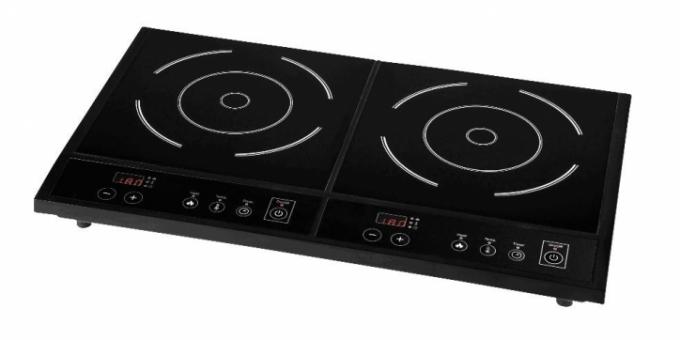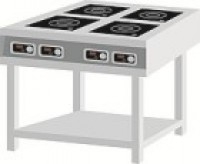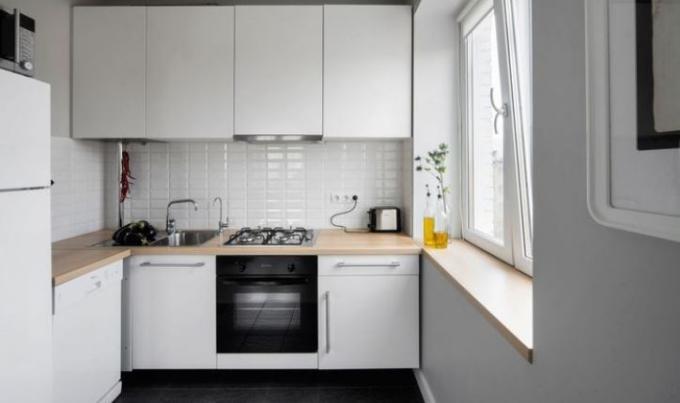Content
-
1 Understanding the essence is important and informative
- 1.1 The essence is the essence, and the benefit is on the face
- 1.2 A few words about technical characteristics
- 1.3 View orientation
- 2 Finally
As paradoxical as it sounds, the fundamentals of the technology used in induction furnaces were formulated by Michael Faraday. The essence of this phenomenon fits well into the school physics course.
Remember, an alternating magnetic field generates an electric field. And then a bunch of formulas and names of prominent people of the early 19th century. With difficulties? But this is not particularly important.
The main thing is that someone discovered this principle, and someone successfully applied it, and as a result, a miracle of modern technology appeared - an induction furnace.

Induction cookers - innovation in kitchens.
Understanding the essence is important and informative

The stand for the stove can be any, the main convenience.
Of course, it’s interesting why airplanes fly and don’t flap their wings, or why new-generation stoves boil water and do not heat up themselves. In our understanding, electric ovens are pancakes or spirals, which, when connected to an electrical network heat up to red, that at least light a cigarette, and, heating everything that comes in their way, boil water in a kettle or saucepan.
A few words about the principles of work, which, of course, will become not only informative, but also clarifying all subsequent material.
Principle of operation:
- As in the experiments of physicists of the 19th century, there is a core formed by a stove and utensils.
Note! Not every cookware can be used on these stoves. Ideally, cookware with a bottom made of a ferromagnetic alloy will do.
- When the magnetic field passes through the dishes, the thermal component of the electromagnetic field is formed, which boils the water.
Note! Unlike conventional electric stoves, the thermal effect is narrowly directed, this explains the fact that the water boils, and the stove itself remains cold. And further! When the core is opened, i.e. removing the pan from the stove stops the field effect.

The essence of the process is a visual aid.
The essence is the essence, and the benefit is on the face

And the chocolate doesn't melt.
And now let's move on to comparison, because in comparison we know the true advantages.
So, the efficiency, or simply the efficiency, for different types of heating plates will be different:
- Surprisingly, gas ovens have the lowest utility rate. Yes, yes, these kitchen assistants we are used to spend more than half of their energy on heating the atmosphere;
- Electric stoves have gone not far from them, their efficiency can differ by a maximum of 10%, and the rest, in the same place - to warm the air;
- The induction oven for the kitchen has the highest efficiency - 90%, and only 10% of the energy is wasted.
Although this is very important and informative, it is only one comparative indicator, so it makes sense to announce the whole range of advantages and disadvantages of these plates.
We announce the advantages:
- High precision of contact with the heated surface. To start the process, it is necessary to cover at least 70% of the surface of the outlined circle on the stove;
- The technique is "smart", when the first condition is met, the stove itself determines the area of the heated object and the necessary efforts to work with it;
- Experts have equipped the equipment with additional programs for various cooking technologies, which significantly saves energy;
- Pieces of food, splashes of water and other attributes of the normal cooking process falling on the surface of such a stove will not burn and will not have a characteristic odor reminding us that we missed something. There is no surface heating;
- The stove looks elegant, looks great both in the built-in form and independently;
- Stove maintenance is not easy, but very simple.
And now about the shortcomings, you can't do without them:
- Prolonged exposure to eddy currents can have undesirable consequences for human health. Although this is more true for chefs and those who professionally work with such equipment, but that is what it is;
- Special requirements for cookware: thermo glass, aluminum will definitely not work;
On a note! The instructions supplied with the stoves contain detailed information on the types of cookware that can be used when working with this stove.
And in order to be 100% sure, use the old, proven method. Take a magnet and place it on the bottom of the dish. If it sticks, it will work, but if it doesn't, it won't.
The check was done by hand - the information content is complete.

Very descriptive photo.
- The stove starts working when the working circle is overlapped by 70%, a kind of sobriety test;
- And one more point, which can be called conditionally negative. Water and food will be ready faster on this type of stove than on conventional gas and electric ones. Therefore, out of habit, water can pour out of the pan, leaving splashes and drips. This is not scary, you will quickly get used to the speed, and the surface of the stove is perfectly wiped, like any hygienic surface - with a sponge and detergent.
- This point is somewhat similar to the previous one, but has the right to be considered separately. Some cooks are accustomed to the fact that when preparing some dishes, especially on an electric stove, they use the method of reaching the desired condition, languishing. On this stove, this effect will not work, when the burner is turned off, the heat effect also stops.
Note! Induction hobs are quite safe to operate, however, due to their operational characteristics, they are not recommended place them directly on ovens, washing machines, dishwashers and other household appliances with metal coatings.
Electric oven for the kitchen - see here.
A few words about technical characteristics

The ice also feels good.
You can talk a lot about the merits of lines and design, embeddability and autonomy, but the best indicators are digital indicators. They are objective and unforgiving.
Judge for yourself:
- We have already mentioned the efficiency, 90% is the maximum that cannot be achieved either with gas or with the help of spirals of electricity;
- Boiling water in a kettle is an excellent comparison. So, to boil 5 liters of water in a kettle on an induction cooker, it takes 1.5 times less time than using gas;
- Unlike a conventional electric cooker, where it takes time to change the operating mode, in induction cookers the transition is carried out instantly, as in gas cookers.
Read also the article "Gas ovens for the kitchen: device, classification, basics of safe use."
View orientation

Concave cooking zones.
Cookers with the principle of the induction principle of operation, as well as conventional ones, are:
- Single burners (single);
- With multiple cooking zones (multi-seat).
And also there is a division according to the state of the surface of the slab:
- Plates with a flat surface;
- Concave hob plates for cookware with spherical bottom;
- Combined plate surfaces.
Finally
To the advantages of induction cookers, you can add economical consumption of electricity, this plus can be appreciated by the owners of cafes and restaurants, where the cooking process takes place practically around the clock. The price of such stoves does not differ much from the price of the usual gas or electric stoves.
It is possible that in the near future these revolutionary developments will replace dangerous electrical counterparts. And finally, our traditional video, it will definitely show the induction product in action.
Read also the article "How to fold the oven for a summer kitchen with your own hands."
